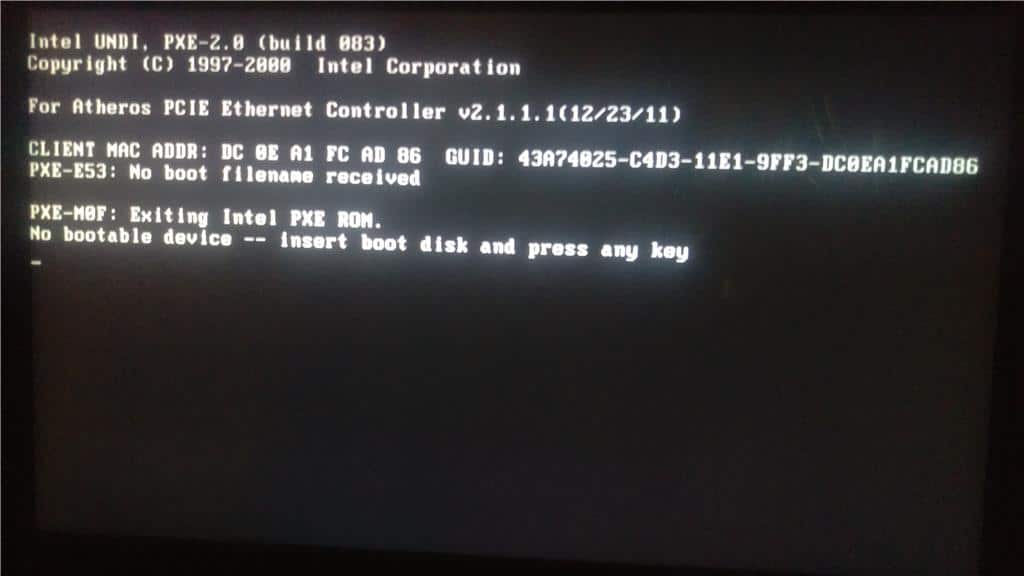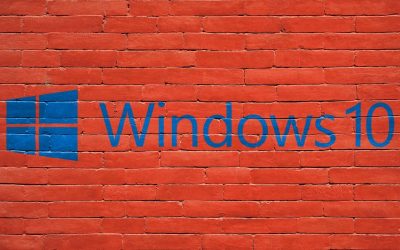How to Fix ‘The System Cannot Find Any Bootable Devices’ Error
Have you ever been stuck with a “No Bootable Device Found” error message on your Windows computer?
The most common cause is your system not being able to access the hard drive. If your system is from an older setup, you may need to turn on legacy boot mode.
If this doesn’t resolve the issue, then it could be more technical than it appears and require further investigation into solutions like reconnecting components, changing BIOS settings, checking the internal hard disk status, or even reinstalling Windows.
My clients have seen this countless times and every time I could fix them by following the guide below 🙂
1. CTRL + ALT + DELETE
Hold down CTRL + ALT + DELETE while your computer boots up and don’t let go until the display appears. This is a quick fix that works most of the time for ‘No Bootable Device’ errors on any motherboard brand.
Here’s why it works:
- It bypasses the BIOS boot order, allowing you to select which device to boot from.
- It can provide access to other troubleshooting tools like memory tests or hard drive diagnostics.
- It forces your system into a safe mode if it has been corrupted, allowing you to repair Windows files without deleting them.
- It allows you to select an alternate boot device in case your primary one fails or is inaccessible due to corruption or incorrect settings.
By taking this simple step, you may be able to avoid costly service calls or hardware replacements and get back up and running quickly and easily!
2. F12 Button
Press F12 when your computer boots up to access the boot manager and select a device to boot from.
This action will bring you to a screen that will allow you to choose which device you want to boot from.
You can select any of the available devices, such as an external drive or CD/DVD drive, or even USB flash sticks.
Make sure that the selected device is set as the default one before attempting to start Windows.
If all else fails, restoring the default BIOS settings may be necessary to resolve this issue.
3. Restore the default BIOS settings/factory settings
If you want to resolve the issue, try restoring your computer’s default BIOS settings. This can be done by pressing the delete button when turning on the computer and navigating to “Save & Exit” where you can select “Load Optimized Defaults.” After saving and exiting the setup, your windows should appear.
- Access BIOS by pressing delete when powering up
- Navigate to “Save & Exit” tab
- Select the “Load Optimized Defaults” option
- Click on Save and Exit Setup
- Windows should appear once complete.
Restoring the default BIOS settings is one of many possible solutions for fixing boot issues in a device. Another way is resetting your computer’s boot priorities.
4. Resetting your computer’s boot priorities
To resolve the issue, try resetting your computer’s boot priorities. To do this, start your computer and press Delete to enter the BIOS. Navigate to “BIOS”, click on “Hard Drive DSS Properties” then set the best option for the device. Now save and exit to observe the results.
| Reason | Solution |
|---|---|
| Incorrect boot priority settings | Reset boot priorities in BIOS menu |
| Misconfigured SATA cable connection | Check/Replace SATA cable connection |
| Hard drive is not detected by BIOS | Update/Replace hard drive firmware |
| Faulty or incompatible RAM modules | Update/Replace faulty RAM modules |
| Corrupted system files | Perform a repair install of Windows |
Afterward, check if there is any connection problem with the SATA cable.
5. Check for connection problem with the SATA or NvME Drive
Unplugging the power cable and inspecting the power/SATA cable can help diagnose a connection problem with the SATA cable. To do so effectively, here are a few steps:
- Unplug the power supply from your CPU.
- Open up the front cover of your CPU to access the internal components.
- Carefully inspect and check that all connectors for the power/SATA cables are securely connected to their respective ports on both ends.
If everything looks good, you may need to replace your hard disk drive (HDD) or solid-state drive (SSD).
If you have an NvME SSD then plug it out and reinsert it back again.
6. Replace the new HDD or SSD
If the connection problem with the SATA cable didn’t work, my last resort would be to replace the new HDD or SSD. This is a significant step and should only be taken after other options have been exhausted.
It’s also important to remember that when changing the OS, it will boot without error problems. To ensure this happens smoothly, I need to make sure any USB devices are unplugged from my computer before proceeding.
7. Unplug USB devices attached to the computer
You need to unplug USB hubs, printer plugs, and external drives from your computer before attempting to reboot. This is because these devices can interfere with the boot process and prevent your system from finding any bootable devices.
It’s important to disconnect them as even if they don’t cause an error on the first attempt, repeated reboots may eventually lead to an issue. Therefore, it’s wise to take this precautionary measure each time you restart to avoid potential problems. After all, it only takes a few seconds and could save you a lot of trouble down the line.
Next up is setting your hard drive as the boot device; this is necessary for the system to find any bootable devices.
8. Set your hard drive as the boot device
Restarting your computer and setting the hard drive as the boot device is essential for successful reboots. To make sure this is done correctly, here are a few steps to follow:
- Enter the BIOS interface by tapping Esc when you restart your computer.
- Move “Hard Drive” to the top of the boot order list using either “+” or “-” keys on your keyboard.
- Press F10 to save these changes.
Restart your machine with this new setup in place.
Making sure that your hard drive is set as the default boot device can help prevent system errors and ensure smooth operating performance – an important factor if you’re looking for mastery over technology!
With this issue resolved, you can begin addressing any other possible causes of system issues.
9. Fix corrupted MBR
If the Master Boot Record (MBR) of your system drive becomes corrupted, you can get the dreaded “No boot device available” error in Windows 10.
Fortunately, this issue can be fixed with a few simple steps.
First, insert your Windows installation media and boot it up. On the “Install now” window, select language and region preferences and then choose “Repair your computer” from the Troubleshoot menu.
In Command Prompt, type each of these commands:
- bootrec /fixmbr;
- bootrec /fixboot;
- bootrec /scanos;
- bootrec /rebuildbcd.
Once they are all completed, exit Command Prompt and restart your computer.
If the MBR is successfully repaired, you should now be able to boot into Windows again. But if not, there may be more serious issues at play that need to be addressed next–namely fixing corrupted GPT.
10. Fix corrupted GPT
To repair a corrupted GPT, you’ll need to use the diskpart command.
- Begin by opening Command Prompt from the Windows RE and running diskpart.
- Then, run ‘list vol’ to list all volumes.
- Select the volume with a FAT32 file system, a Label of ‘Boot’, and an Info field of ‘System’.
- Assign it a mount letter.
- Exit Diskpart once you’re done.
- Next, cd into the directory containing boot files: either EFIMicrosoftBoot or Boot or ESDWindowsEFIMicrosoftBoot.
- Finally, run bcdboot :Windows /s : /f UEFI and then rename BCD to BCD.backup before running bcdboot again with flag ALL.
- Reboot your computer afterward to check if this fixed your error.
Moving on, we’ll look at how to check Secure Boot settings…
11. Check Secure Boot Settings
Check your Secure Boot settings to make sure your computer is protected. To do this, you will need to enter the BIOS interface of your motherboard.
Hit the BIOS key (e.g., Del for MSI) until you get to the Settings section. Then go to Advanced, select Windows OS Configuration, and choose Secure Boot. Once there, disable the option and save by pressing F10.
This simple workaround should help protect your system from malicious codes and make sure it detects new storage drives as trusted bootable sources.
Additionally, enabling Compatibility Support Module may be necessary for certain older systems.
12. Enable Compatibility Support Module
To enable backward compatibility for your PC, you need to enable the Compatibility Support Module (CSM). This is necessary if you are running UEFI firmware but have an MBR partitioned storage drive. CSM allows the operating system to detect the drive as a bootable device.
To enable CSM, you need to go into the BIOS settings. Set the BIOS/CSM mode to CSM. If you find that the option is greyed out due to integrated graphics, you can try installing a dedicated graphics card instead.
After saving the settings and exiting the BIOS, your system should now be able to detect bootable devices. With this solution in place, transitioning into trying a change of boot mode should be easy.
13. Try Changing Boot Mode
Try changing your boot mode to see if it helps you detect a bootable device. This may be necessary if the system isn’t recognizing any bootable devices connected to it, even though they are properly connected and should be detected.
Changing the BIOS or UEFI setting to another mode could help in detecting the right devices. It is important to make sure that when you change the settings, you select the one that best fits your hardware configuration. If unsure, consult with a specialist or refer to your manufacturer’s instructions on how to do this correctly.
After setting up the appropriate boot mode, try restarting and seeing if any of your connected devices can now be detected by the system. If successful, you’ve solved your problem!
Otherwise, you may need to move on to making sure that the system partition is active for it to recognize any booted devices.
14. Make the System Partition Active
To get your computer to detect bootable devices, you’ll need to make sure the system partition is active.
To do this:
- Insert a Windows installation media and boot your device from it.
- Enter the Windows Recovery Environment and select ‘Troubleshoot’.
- Open Command Prompt and utilize the diskpart utility.
- Execute commands to set the active partition and exit the Diskpart utility.
This should fix your issue, but you should also check other BIOS settings for further optimization.
15. Check Other BIOS Settings
Check the other BIOS settings to ensure your device is optimized. This includes making sure that secure boot is enabled, TPM settings are set up correctly, and all other security-related configurations are in place.
Additionally, check that your UEFI/BIOS Boot Mode is set to Legacy or UEFI as per your requirement. You should also make sure fast booting options such as quick boot and ultra-fast boot are disabled so it can detect any newly installed hard drives or devices.
Lastly, if you have a USB drive connected with a Windows installation media, make sure it’s listed in the Hard Drive Priority list of the BIOS menu for the system to recognize when restarted.
With these settings taken care of, you can move on to performing a clean install of Windows.
16. Convert MBR to GPT
To convert your MBR-partitioned drive to GPT, follow these steps:
- Open Command Prompt and run the ‘diskpart’ command.
- Execute the command ‘list disk’ to check if there is an asterisk in the GPT column. If there is, it means your drive is already GPT. If not, it is MBR.
- Use the command ‘select disk ‘ to select the correct disk number.
- Run the command ‘clean’ to remove all partitions on the selected disk.
- Choose either ‘convert mbr’ or ‘convert gpt’ to convert the partition style from MBR to GPT or vice versa.
- After the conversion is complete, exit the Command Prompt by typing ‘exit’.
17. Clean Install Windows
Clean installing Windows is the best way to ensure that all of your corrupted MBR and boot sector data are replaced. It requires you to use a Windows installation media and follow the setup instructions. After deleting all partitions, you can customize them as per your requirement.
| Pros | Cons |
|---|---|
| All damaged files wiped clean | Time-consuming process |
| Latest OS version installed | Loss of user files if not backed up |
| Easy to configure settings | Requires product key or activation code for full functionality |
Installing Windows this way ensures a smooth running system with no existing problems from before. However, it’s important to remember that it also comes with the risk of losing any unsaved user files. Therefore, backing up important information beforehand is highly recommended. Transforming an MBR partitioned drive into GPT will be our next step toward fixing this issue.
Once your hard drive has been converted to the appropriate partition style, you can proceed with the solution for Dell motherboards brand that involves addressing the “no bootable device found” issue.


